Swordfish: varieties, selection, care, reproduction
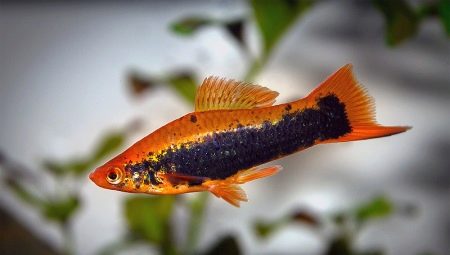
The swordsman is one of the most unpretentious, and therefore the most popular aquarium fish. At the same time, the fish are bright and beautiful, so they can safely be considered one of the first options for a person who is just starting his way in aquarium hobby. Naturally, the beginner does not yet have sufficient experience in breeding and, by virtue of this, may inadvertently make a mistake, due to which he may be expected to fail. To prevent this from happening, consider what kind of pets they are and how to behave correctly with them.
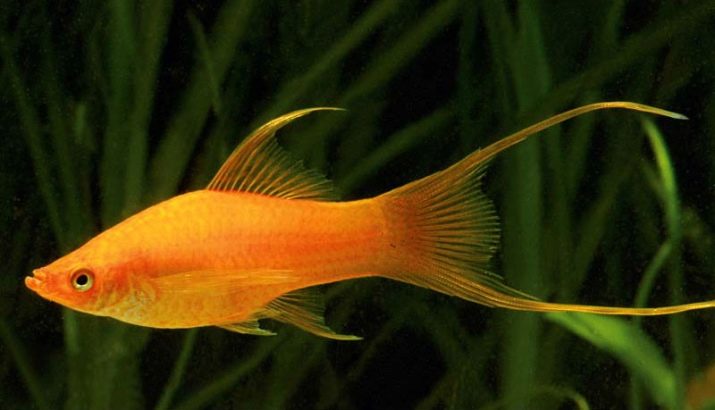
Description
The swordtail fish looks very much like another popular aquarium inhabitant - the petsilia, and it should not be surprising that they are related not only by their external similarity - in terms of biological classification, both species belong to the petsilia family. The birthplace of the swordtails should be considered Central America and the southern part of Mexico, in whose waters this beauty lives.
By the way, in the wild, such a fish looks slightly different than in an aquarium - it has a characteristic green color, whereas aquarists are accustomed to its inherent red tones. She was led to this appearance by breeders, who once noticed that closely related swordtails and platies interbreed well, giving offspring of curious appearance. It is thanks to such experiments that today there are many species of aquarium swordtails.
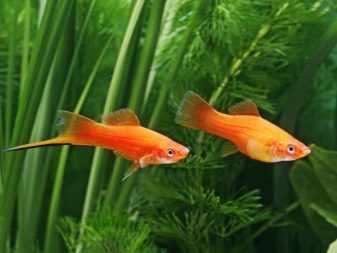

A unique feature of this species, which even more attracts aquarists, is that, if necessary, the fish can change sex - at least from female to male.This is very useful for the population, because in a limited space, for example, in the same aquarium, the entire population can consist exclusively of females, at first glance, such a community has no future.
Evolution has provided an interesting way out of a difficult situation - some females in such conditions turn into males and are able to give offspring along with their girlfriends. True, such a pair also gives birth to only females, but nothing prevents the fish from doing a similar trick from generation to generation.
Unlike many other aquarium fish, domestic swordtails are on average slightly smaller than those found in the wild. Females are somewhat larger, their length is about 13 cm, but the male is more modest in size and rarely outgrows 10 cm.
You can distinguish between representatives of the two sexes by the most obvious sign, which gave the fish its name - the male has a characteristic narrow and long process on the tail, the so-called sword... Changing sex, the female grows such a sword, and some varieties bred by selection may even have several swords at once. In its natural environment, the swordtail is a gray-olive fish, whose body is decorated with longitudinal stripes of a slightly reddish hue, although they are more pronounced in males, they are still present in both sexes.
At the same time, the breeders took care of the diversity of the appearance of the underwater inhabitants, so the tone of the stripes can be almost anything - red, yellow, black, and so on.
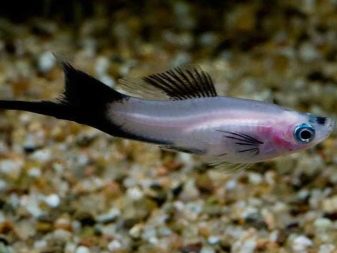
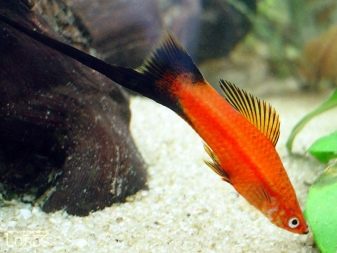
Views
As it was said, the modern aquarium swordsman does not correspond too much to its wild relatives - it is almost always the fruit of complex breeding work. The fish, green with a grayish tint, is no longer very popular today - it was replaced by varieties that differ in color, body shape, and so on. Consider what these cute pets are like.
- Green sword bearer quite close to the original, but its ebb is not gray, but brown, and the stripes on the body are not so much red as light. A characteristic feature is the colored edging along the sword in males.

- Lemon variety is considered an albino, but at the same time it is not white - it has a bright yellow color with an admixture of green tones. Breeding such fish at home is almost impossible, since such a mutation is rarely transmitted from parents to children.
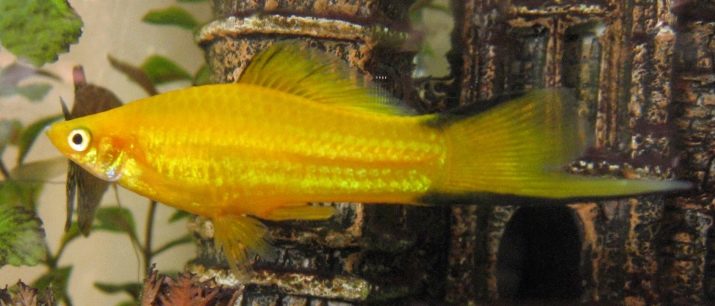
- Bulgarian white similar to the subspecies described above, only its albinism is more pronounced - it is a completely white fish. As in the case of the lemon counterpart, breeding such a handsome man is very difficult for the owner.
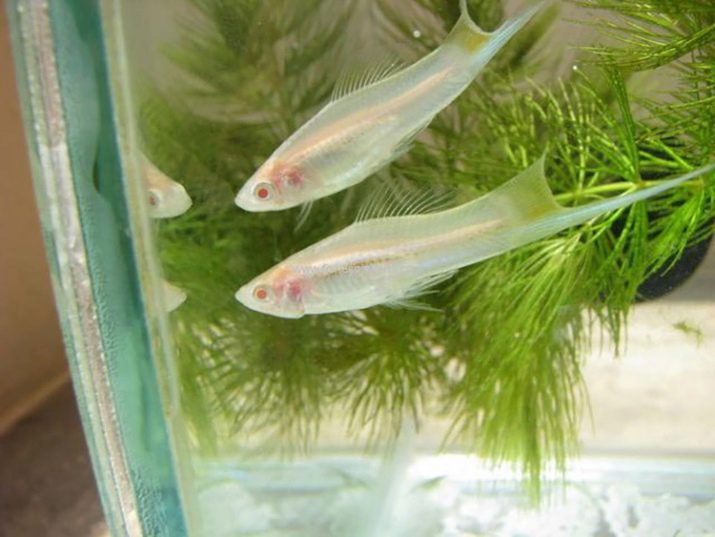
- Red sword-bearer - one of the most common options for such living creatures, since it is beautiful and well-bred. It is one of the most recognizable breeds, although it is she who has many genes not only from the original swordtails, but also from the platy.
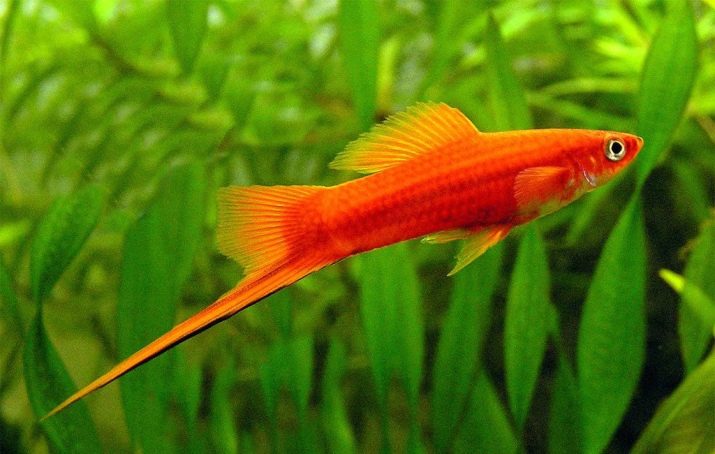
- Black swordsman it is not so widespread, but it is also a descendant of a platia - only not red, but a rarer black one. The blackness of the pet is not impenetrable - there is a blue or green tint in it.
Such a bright color has a negative effect on living creatures - they tend to get sick and reluctantly reproduce.
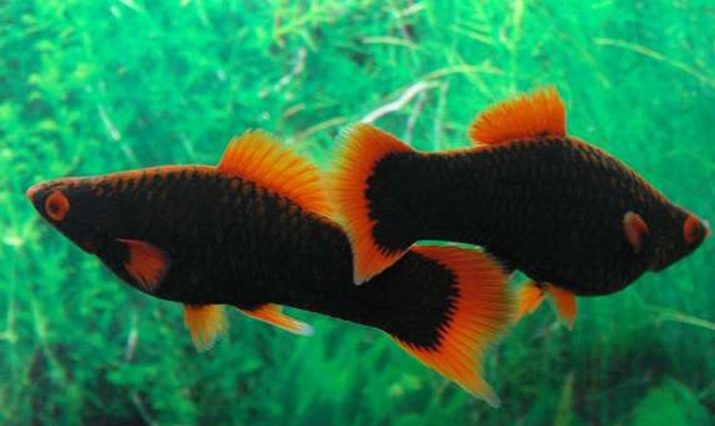
- Calico subspecies, also known as tricolor, could be considered an albino as its predominant body color is white. However, it is adorned with a pattern of spots of black and red, which makes it remarkable.
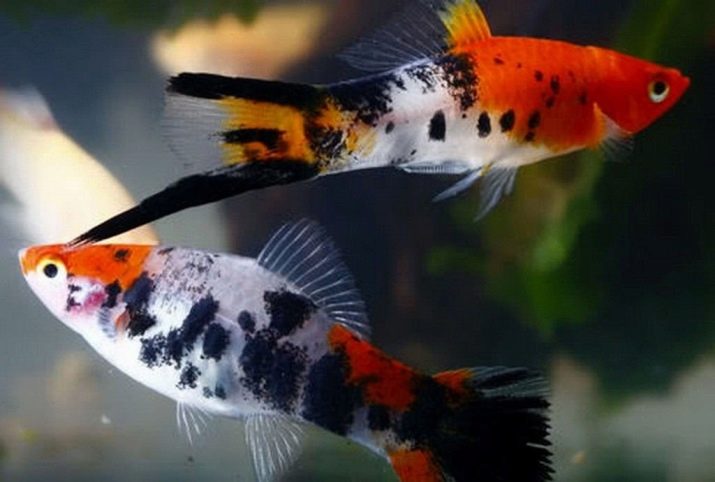
- Rainbow variety even among experienced aquarists, not everyone saw it, since it is not sold everywhere. The fish is distinguished by a characteristic color overflow of scales.
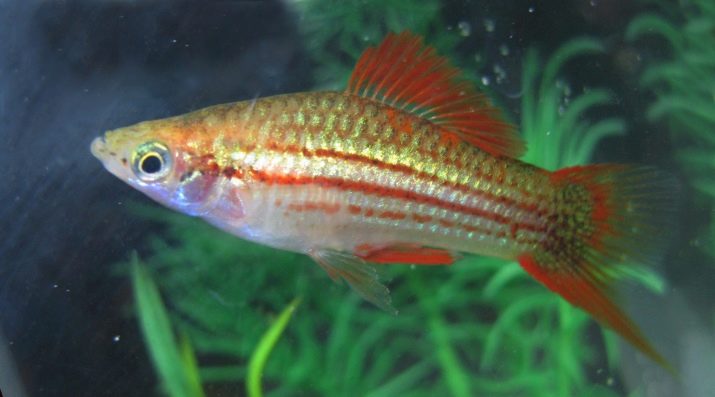
- Yellow swordsman often also called mountain. It is characterized by a delicate yellow color, which is still not completely monochromatic: on the sides it is decorated with pale stripes in the form of zigzags and specks of the same color.

- Tiger variety is in demand among breeders for the simple reason that it gets sick much less often than many of its "colleagues". Her body is red, but her sword is black, and black specks are scattered all over her body, reminiscent of the colors of a land predator.
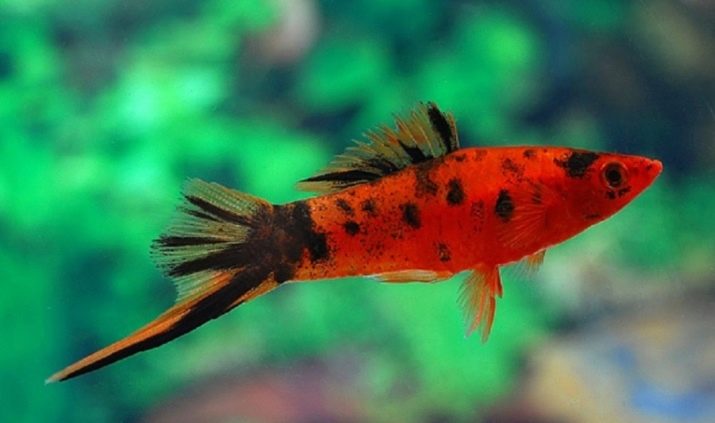
The joint keeping of representatives of different subspecies of swordsmen is not prohibited - they peacefully coexist with each other and can cross, giving offspring of a completely unexpected appearance.
At the same time, the amateur simply will not be able to make the resulting beautiful generation pass on its appearance to the descendants, so the selection work should still be left to professional breeders.
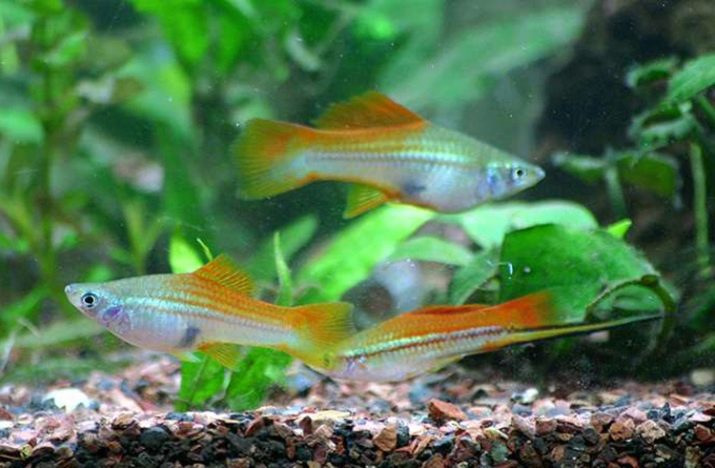
How to choose?
Most novice aquarists, having heard that swordtails are among the least whimsical aquarium fish and come in a wide variety of colors, they immediately decide to purchase these pets in different variations. Their logic is simple - representatives of this species get along well with each other, care for all of them is the same, and even the offspring can have an unusual and original appearance.
This logic is not entirely correct, because in the aquarium industry there is a general rule that complex hybrid subspecies are more difficult to maintain than those that are close to natural ones. Fish breeders rarely pay attention to traits such as health or adaptability to difficult conditions, therefore hybrid fish are beautiful in appearance, but weak and defenseless. In this context, it is worth starting with the green, red and tiger swordsmen, which are really quite resilient, and you can move on to the colored breeds later.
If you are a “true gourmet” and want to breed those breeds that have changed not only the color, but also the shape of the body, be prepared that such pets will turn out to be extremely demanding on the conditions of detention, and without first studying the topic, you will almost certainly suffer an offensive defeat.
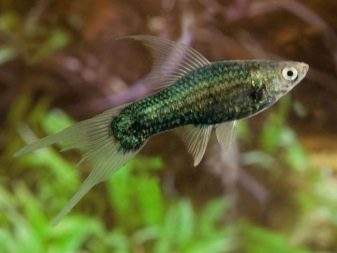
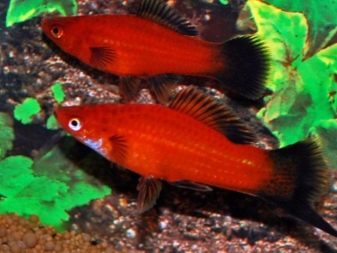
Another important point is the selection of the population by gender. Some newcomers are so shocked by the information about the possibility of housing creatures that can change sex in their homes that they purposefully acquire same-sex fish. It is important to take into account at least the factor that only females can become males, but not vice versa, which means that a population consisting of only males has no chance of procreation.
In addition, the sex reassignment mechanism is nature's backup plan in case of unforeseen situations, and it simply allows the species not to die, but this does not mean that it is equivalent to full-fledged sexual reproduction.
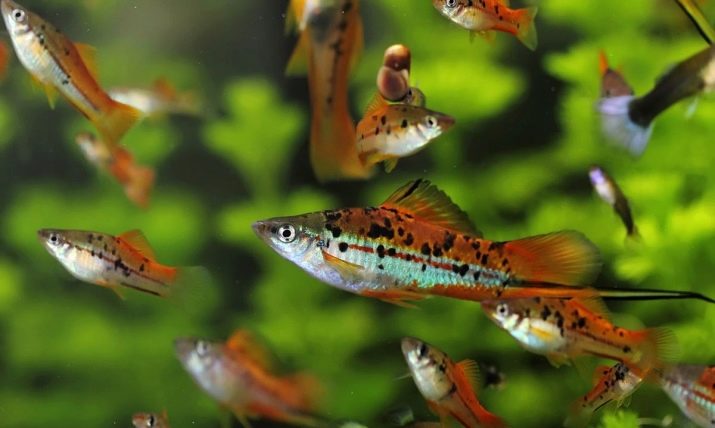
How to distinguish a female from a male?
An important advantage of swordtails over other aquarium fish that attract the same newcomers is the ease of distinguishing between aquarium inhabitants by gender. Even without an alternative individual for comparison, you will most likely be able to identify the sex of each individual fish.
- Sword. On this basis, even a child recognizes a male - the caudal fin of a male in the lower (abdominal) part has a characteristic elongation, greatly exceeding the length of the rest of the fin. This is the same sword that gave the name to the whole species, but traditionally only men carry weapons.
- Caudal fin. If we are not talking about a complex hybrid subspecies, and the presence of a sword for some reason raises doubts, pay attention to the fin as a whole. In the male, the main energy is spent on growing a long and bright sword, so the rest of the fin looks modest - it is not distinguished by any special length or high density. His girlfriend has a bushy tail.
- Dorsal. In the male, this organ also has an elongated shape - its length is sufficient for the fin to bend towards the back of the body during rapid forward movement. In the female, the dorsal fin is wider, but noticeably shorter - there is nothing special to bend there.
- Dimensions. Due to the fact that breeding work and close aquarium conditions make their own adjustments, it is more worth focusing on this trait only if you have a population of fish born in one batch. The male is always about a quarter shorter than his girlfriend, unless the lady is of the kind that is, in principle, small. At the same time, for the female, the maximum size is 13 cm in length, and for the male - 10 cm, so that any individual longer than 10 cm can automatically be assigned to the weaker sex.

Content rules
Swordsmen are beautiful not only for their appearance, but also for the fact that taking care of them is completely simple - this is a surprisingly unpretentious look. If you still do not neglect the few requirements that this pet nevertheless puts forward, you can safely expect that it will delight you for a long time - these fish live in an aquarium for 5-6 years. So that you understand how easy it is to care for such animals, pay attention to the following optimal conditions for keeping:
- the water temperature should ideally be + 24-26 degrees, but the fish will not die, even if there is a drop to +15 degrees; experimenting in this way is not worth it, but in emergency conditions the population is still unlikely to die;
- for swordsmen, a careful choice of water in terms of hardness is not needed - they are completely choosy in this regard; any liquid with indicators from 8 to 25 dH will suit them;
- with acidity it is a little more difficult, but also not very strong - 7-9 pH will do.
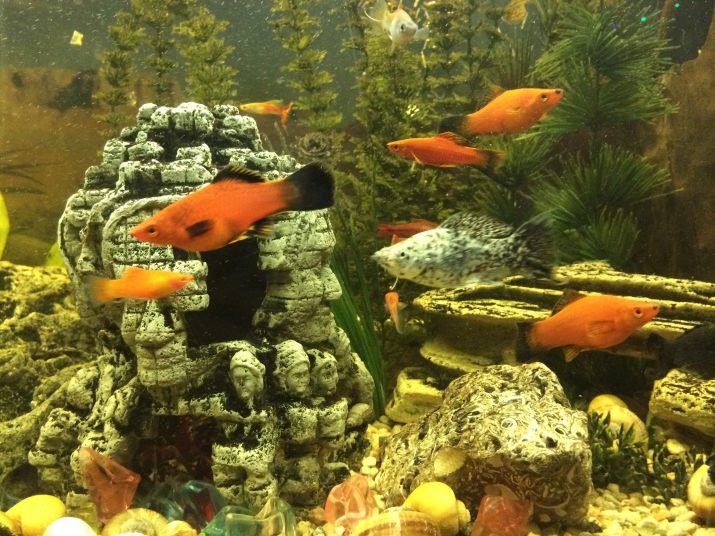
You can feed pets with almost anything from the arsenal of the nearest pet store, so that the owner can freely choose, focusing on the finances or features of the range of the nearest point of sale. Dried daphnia and bloodworms, dry flakes and brine shrimp, even special granules - all this is good for food. What especially pleases aquarists is the ability of fish to search for food on their own inside the aquarium - this is possible if you have taken care of planting live plants and added small snails to the pond. On such grazing, pets can survive for a week or even two while you go on vacation or a business trip.
Water change, according to the recommendations of specialists, is carried out once a week, and immediately in a significant amount - by a third... In addition, swordsmen need oxygen, which is sorely lacking in the summertime - this requires the owner to keep both the aerator and the cooling system turned on around the clock. Males armed with swords love to drive around the aquarium, so they often jump out of it. This, of course, is fraught with the death of the fish, therefore, an artificial reservoir is usually covered with a lid.
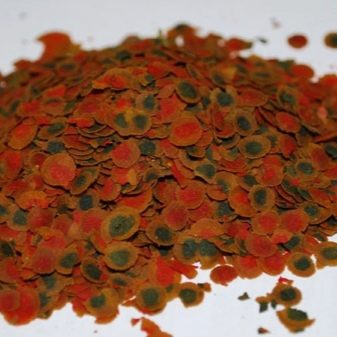

Equipping an aquarium is also easy - it is suitable as a bottom any standard medium fraction soil. In this case, a soil substrate is necessary, since it is highly desirable to plant live plants - in the wild, fish feed on them, and they will also become your depreciation in case you have to leave, and there is no one to leave the living creatures.
In addition, swordsmen like to hide in thickets, so this will add to their comfort. The volume of the container strongly depends on how many fish you have and what size they are. In general, one should be guided by the fact that a large female, whose dimensions reach 10-12 cm, will require one 10-15 liters for herself, while for a single individual it is worth counting on the maximum capacity indicator.
If there are a lot of fish, you can already look at the minimum recommended indicator, but it still turns out that for a company of six fish you need an aquarium of at least 60-70 liters.
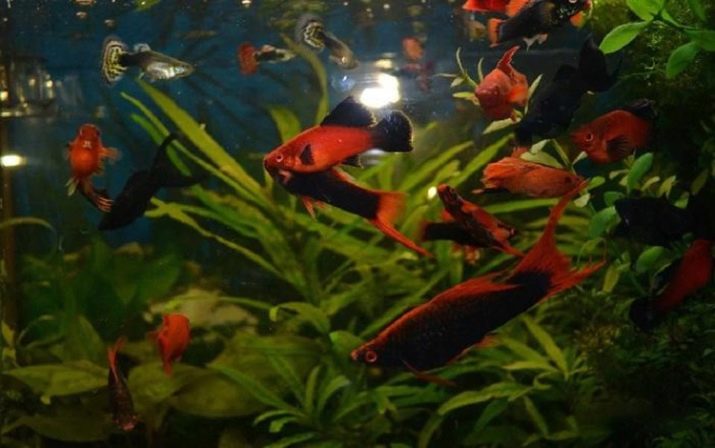
Breeding
For those who are not yet in the know, let us highlight one more important feature of the swordtails - this fish does not spawn, since it is viviparous. If you want to get offspring at home, and, in general, organize the correct, healthy population, you should select it so that there are 3-4 females per male. At the same time, many experts advise using at least three males in a population of five individuals - they do not drive their friends, since they, in principle, tend to choose only one, the largest and strongest.
Swordsmen do not need any additional stimulation in order to produce offspring, but a person can create such conditions in which the fish feel as comfortable as possible and can fully devote themselves to the implementation of instincts. So, it is advisable to keep the water temperature at + 26-27 degrees, nitrates and ammonia should be as little as possible (clean the aquarium more often and change the water), and the recommended acidity is 6.8-7.8 pH.
A fertilized female, having become pregnant, bears offspring for approximately 30-40 days. The condition of the fish, which is likely to become pregnant, should be monitored. Obvious signs of an interesting position are a noticeable gain in weight and the appearance of a characteristic dark spot near the anus - this is visible through the skin of the fry. The last sign is a signal that a potential mother should be placed in a separate tank, since adult swordtails are not distinguished by high morals and will gladly feast on their own children.
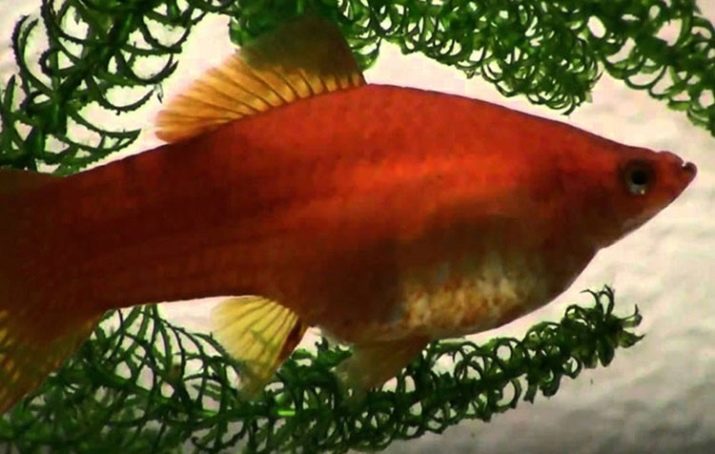
A small aquarium or any vessel resembling it, whose capacity is 15-20 liters... It is important to adequately equip such a reservoir: at least there are needed seaweed, because the mother prefers to give birth in them, and the children will have a place to hide if she gets hungry. However, one should not rely on the amazing protective power of the thickets, so it is advisable for the owner to monitor the condition of the young mother - as soon as she completely gets rid of the cubs in her body, she can be caught and sent back to the common aquarium.
The number of babies who will be born at one time is difficult to predict in advance - there may be 15 or 150. The number of litters is influenced by numerous factors, including the size of the mother herself, her age, and the "correctness" of the conditions created by man.
Young people do not need care from their parents, but they are very active and will never refuse to eat. There are quite a lot of food options for them, but here the choice is still not so big - most often they are fed with something like Artemia nauplii, egg yolks or grated flakes. As an alternative, flakes with fiber or spirulina will also work, but these are just additions to the above, and not a full replacement.
Babies have no place in a common aquarium until they grow up enough so that there is a guarantee that their older brothers will not be able to eat them physically. At the same time, the development of young animals is uneven - the stronger and more agile ones manage to collect more food, so they grow faster, and someone gets a chance to fully grow only after the leaders leave.
For this reason, breeders usually do not release all the inhabitants of the spawning ground into a common aquarium at once, but do it in batches.
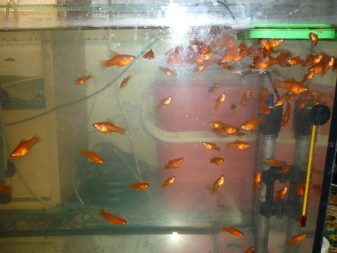

Breeding swordsmen at home, as we can see, does not present any particular difficulty, and the population can grow rapidly. For a small home aquarium, simply unable to accommodate a large population, a demographic boom is undesirable, and after all, males of this species are usually very active and will not voluntarily give up their basic instinct. For this reason males and females are often advised to be kept separately - This is practically the only method of controlling the population.
A novice aquarist must also know that a female, even after one episode of mating, is able to please her owner with several litters at once. This is because females of this species are able to retain milk in themselves for several months, while one pregnancy lasts no more than one and a half.Having given birth to the next batch of fry, the female is able to become pregnant again without contact with representatives of the opposite sex, so that separate keeping in conditions of even prolonged separation is still not always effective.
In addition, it must be remembered that the female company of swordsmen, deprived of male attention, is sometimes able to find masculine traits in one of its members, so the problem of potential overpopulation is traditionally one of the most acute.

Compatibility with other fish
Most sources describe the swordsman as a relatively peaceful fish, but there are certain nuances. So, experts note that with a relatively small number of females, males do not get along in one aquarium - a stronger male chases a weaker one, not seeing another way to divide the territory.
Professionals note that the rivalry between males is not so pronounced, if there are even more males in themselves, regardless of the number of females: these fish do not know how to build a complex hierarchy, they can only clearly understand who is the leader and who is the subordinate. Most other popular types of aquarium fish can be hooked up to swordtails. - there are neons, guppies, mollies, and even catfish with scalars and gourami.
In fact, swordsmen can be kept with any other inhabitants of the underwater world, provided that the neighbor does not turn out to be aggressive and corny larger, which will allow him to simply devour his companion.
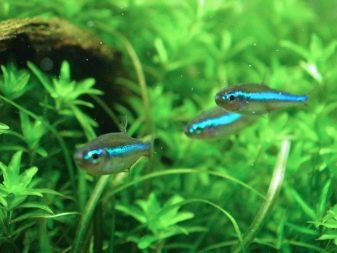
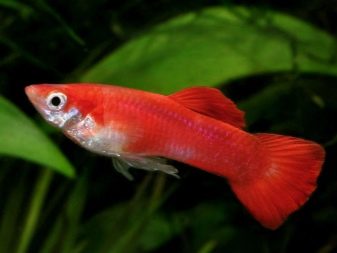
Potential enemies of swordtails are large and very aggressive fish, which usually do not live in beginners' aquariums, but are still actively bred by experienced aquarists. All these akars, astronotuses, cichlazomas and so on have a rather violent disposition to bully their neighbors. Even without devouring a neighbor, they can ruffle him a lot. The swordtails themselves rarely bully representatives of other species, but there are still exceptions, namely:
- veiled goldfish are of unhealthy interest for them - a sword-bearer can bite off fluttering fins of others;
- in a too cramped aquarium, this fish can attack its neighbors, believing that they have got too close to it;
- some old males are capable of showing unreasonable aggression towards others.
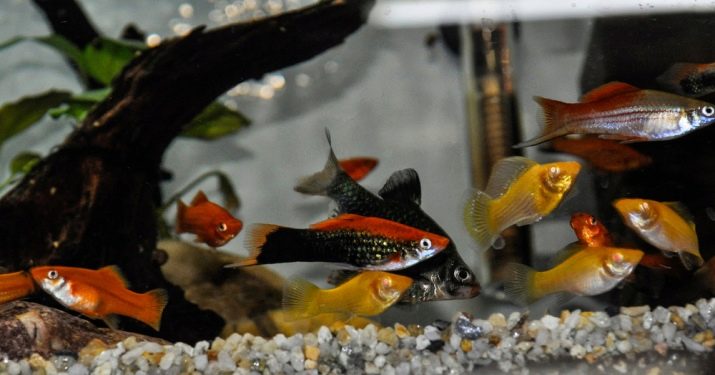
For even more details on the features of the sword bearers, see the next video.








